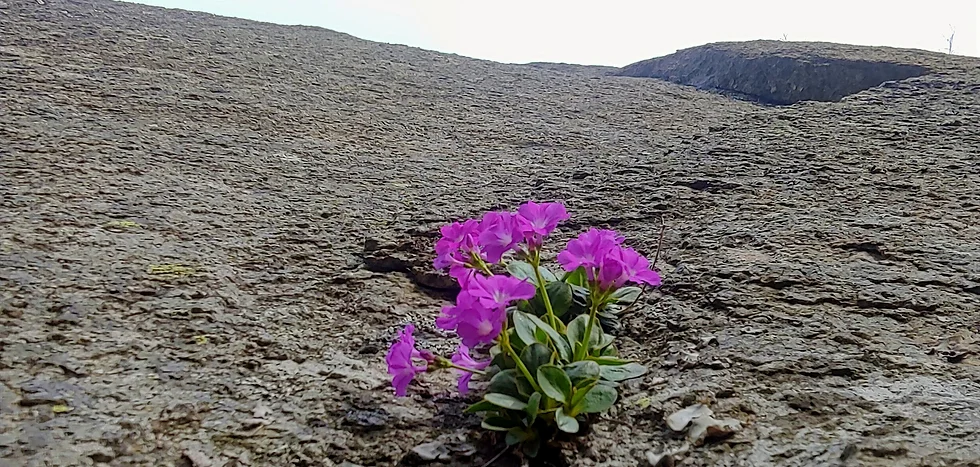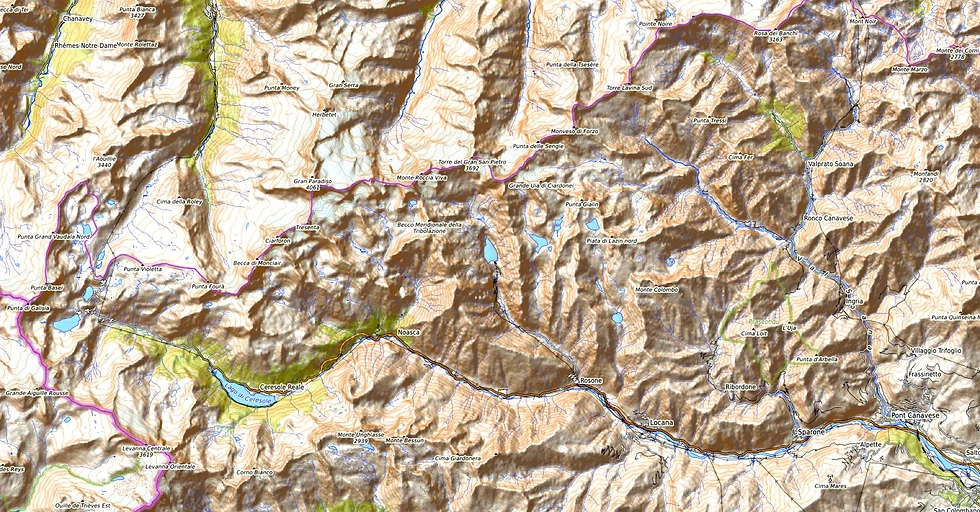
History of climbing in Valle Orco, taken from the book “Valle dell’Orco“, published by “Versante Sud” by Maurizio Oviglia, a protagonist, flourishing opener, and one of the leading experts of Valle Orco.
Valle dell’Orco is one of the most important Italian valleys and, with a length of over forty kilometers, serves as the gateway to the entire southern slope of the Gran Paradiso Group, trending west-east, perpendicular to the “Valle d’Aosta” on the northern side of the group.
This is actually a somewhat strange fact, explained by the greater erosive force of the Orco River, which did not adapt to the maximum slope like the watercourses of Valle d’Aosta. Instead, it profoundly influenced the underlying gneiss, creating the typical landscape of Valle Orco characterized by beautiful rocky gorges, such as the one before the Ceresole basin. Valle Orco is rightfully renowned for its beauty today: with its side valleys, it is a true microcosm dominated by rock, especially the famous gneiss that seems to occupy every corner of the valley with slabs, walls, and rocky spurs.
This feature, shared with the adjacent “Val Grande di Lanzo,” has made the valley one of the mythical places for granite climbing in Italy, akin to “Val di Mello” in the Central Alps. What makes the walls of Valle dell’Orco special, at least for climbers, is primarily the “Gola di Balma Fiorant,” where exploration of a series of walls began around the early seventies, which had gone unnoticed until then.
The beauty and uniqueness of some of these walls led to a comparison with the Californian Yosemite Valley, albeit on a smaller scale. With the ascent of the first routes on the most suggestive wall, called Caporal, exploration continued upstream and downstream of the gorge.
Above Ceresole, Sergent was climbed, while above Noasca, it was the turn of “Torre di Aimonin”, and then a whole series of minor structures. This granite island in the middle of the valley ended up being considered by climbers a microcosm on its own, as if the rest of the valley (and the mountains) did not exist: “Valle Orco” was for years and for climbers only the stretch from the village of Rosone to Ceresole. Over time, however, even the mountains dominating the valley, such as “Mare Percia,” “Courmaon,” “Monte Castello,” “Gran Carro,” assumed their own mountaineering identity. A similar process took place, on closer inspection, also in “Val di Mello,” where exploration of the granite structures of the lower valley took place during the same period.
So, in conclusion, we can say that we are dealing with a valley with a rich mountaineering history that has now become almost a legend, at least when reading what has been passed down by the bards of that era defined as “Nuovo Mattino,” precisely identifiable in the first half of the seventies. A mountaineering history that has not always been steady but has also experienced long periods of stagnation. Each wall described is a piece of this history, but, of course, the history has been made by humans, and the climbers who wrote it were many, making it difficult to talk about all of them without forgetting someone. While the most famous ones operated on almost all the walls, the more discreet ones often stuck to the smaller walls, almost electing them as their personal gardens.
In the days of “Nuovo Mattino,” Valle dell’Orco was nothing but the garden of a few somewhat revolutionary climbers, a secret garden that, if not for the happy pen of “Alessandro Gogna,” “Gian Piero Motti,” and “Andrea Gobetti,” might have remained little known. In the following years, despite the aura of myth and legend that has always surrounded these rocks, the valley has remained an extremely provincial place, frequented by locals and some curious visitors from afar.
In recent times, things are changing, and foreigners are becoming more and more present on the walls of Sergent and Caporal. Some famous cracks have earned the cover of magazines and the honor of online chronicles because the best international specialists in the art have come to climb them. Perhaps it is time for Valle dell’Orco to be recognized and take its rightful place among the sanctuaries of European climbing. Its history is certainly fascinating and must be passed down and told to those who come from afar, but these walls cannot live on past glories alone.

Valle dell’Orco begins from the town of Cuorgnè, located at the foot of the mountains. Following the new expressway, you quickly reach Pont Canavese, which can be easily avoided on the left. However, for those interested, in the center of the town, there is the opportunity to climb on the “urban” cliff of Rogge. Instead, following the bypass and looking to the left, beyond the river, you can see a dark wall. It is the cliff of Luca (Luca Basolo), one of the last equipped sport climbing walls and, for a long time, frequented only by local climbers. Resuming the original road, you also leave Sparone (552 m) and the small Valle di Ribordone, which opens on the right. On these sunny slopes is hidden one of the most frequented cliffs in the area, Frachiamo, which is reached by a narrow asphalted road. Continuing in the main valley, you will see on the right the cliff of Bosco, perhaps the best-known for sport climbing in the area. Sheltered from rain and relatively warm in winter, it is very popular for much of the year. A little further on, you reach the capital of the valley, Locana (613 m), 12 km from Pont.
The valley takes on its characteristic rocky and enclosed appearance here, and, just beyond the town, you can stop for a beautiful view of the Vallone di Plantonetto and the Becco della Tribolazione. You pass through some small hamlets of a few houses and reach Rosone (715 m), the beginning of the Valle di Piantonetto, 16.6 km from Pont. Following the narrow road to San Giacomo, you can reach the rocks of Bugni at the beginning of the Vallone di Piantonetto and in a good panoramic position on the central part of the valley. Beyond Rosone, the valley bends slightly to the west, changes character, and becomes more enclosed.
On the left, dark walls appear, among which is, hardly noticeable, the structure of Zeppelin. At its base, on a boulder, is the extremely difficult crack of Greenspit, considered perhaps the most difficult in Europe. After passing through a gallery, you reach the Fornolosa hamlet (742 m), where you can admire the rocky walls on the left side, many of which are practically unexplored. Narrow granite gorges hide tall waterfalls, while more than 2000 meters of elevation separate the valley floor from the watershed with Val Grande. You pass through some small hamlets, including Gera, located under a series of granite outcrops, this time on the right side of the road. This area is one of the last frontiers of exploration in the valley and has so far remained quite unknown, known generically as Bambanero.
In the background, you can admire Courmaon on the left of Vallone del Roc. Gradually bending towards the northwest, the road reaches Noasca (1058 m), 25.8 km from Pont, famous for its beautiful waterfall. Before reaching the village, you can admire on the left the beautiful wall of Torre dell’Alpe Costantino, while on the right, the slab of Torre di Aimonin is clearly visible, supported by a scree of large blocks.
Two steep switchbacks are the gateway to the “mythical” heart of the valley: you arrive on a narrow plateau, the Pian Dlera (1250 m), now at the beginning of the gorge of Balma Fiorant, famous for its walls.
On the left, you immediately spot a large and dark wall, the base of which is characterized by a forest completely devastated by winter avalanches: it is the Parete delle Ombre (Wall of Shadows).
The road now continues in the gallery that avoids the narrow gorge, but it is possible to follow for a stretch the old road (arranged for the 2019 Giro d’Italia but closed to cars), which runs alongside the structure of Caporal.
At the beginning of the tunnel, on the right, there is the asphalted branch that leads to the Balmarossa hamlet, the starting point for the Vallone di Noaschetta. Skipping the gallery, you enter the gorge, passing between two huge stones with fascist-era inscriptions. On our right, small granite structures in the form of slabs offer beautiful adhesive climbs: Placca del Cacao, la Piramide e il Cubo (the Pyramid and the Cube), at the summit of a short scree.
At the top and on the right, visible in a row, is the Caporal, the most famous and beautiful wall in the valley.
Continuing uphill, also admiring the other side of the valley, which has significant granite walls: Archi Neri, Torre Paura dal Cervello, and the large wall of Serpente di Legno. Continuing along the small road, you reach a square with an old abandoned yellow crane. A series of large rocks marks the beginning of the Caporal’s basal scree. These rocks, already known in the golden age of “Nuovo Mattino,” have recently been revisited in a modern key. With two narrow switchbacks, you are brought to a widening below Caporal, where the road enters the gallery and it is no longer possible to follow the old path.
You emerge from the tunnel in the upper part of the valley, very wide, facing the group of Tre Levanne, where the broad snowy channel of Colle Perduto stands out. On the left, the old road branches off, which can be retraced for a stretch, back towards the gorge left before.
On the left, against the tunnel, there is the famous boulder of Fessura Kosterliz, and above it, the large wall of Sergent; what can be seen from here is just a portion of the entire wall!
In front, on the right orographic side, there is the Parete del Disertore, surrounded by beautiful larch woods.
A little further beyond the Sergent square, walking down the road, you can see on the left the Parete dei Conflakes, recently valued.
Continuing from the exit of the gallery upstream, you reach the first houses of Ceresole at the Prese hamlet (1501 m), 32.7 km from Pont.
Respectively on the right and left, hidden by larch trees, two beautiful cliffs recently equipped: il Droide and la Pietra Filosofale.
Unmistakably on the right is il Dado with its beautiful cracks, while you will have to climb above it to find the most famous of all, Sitting Bull.
With a gentle ascent, you pass through all the fractions of Ceresole in sequence, lying on the shore of the homonymous lake, dammed by a large dam; 1613 m, 35 km from Pont.
The road skirts the lake


